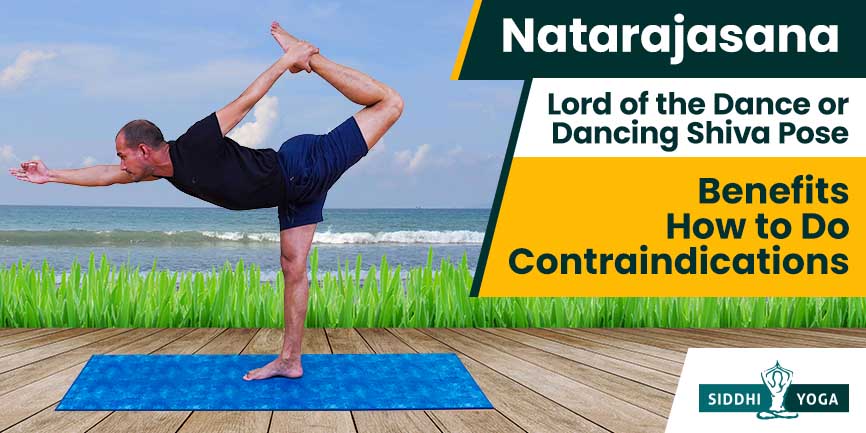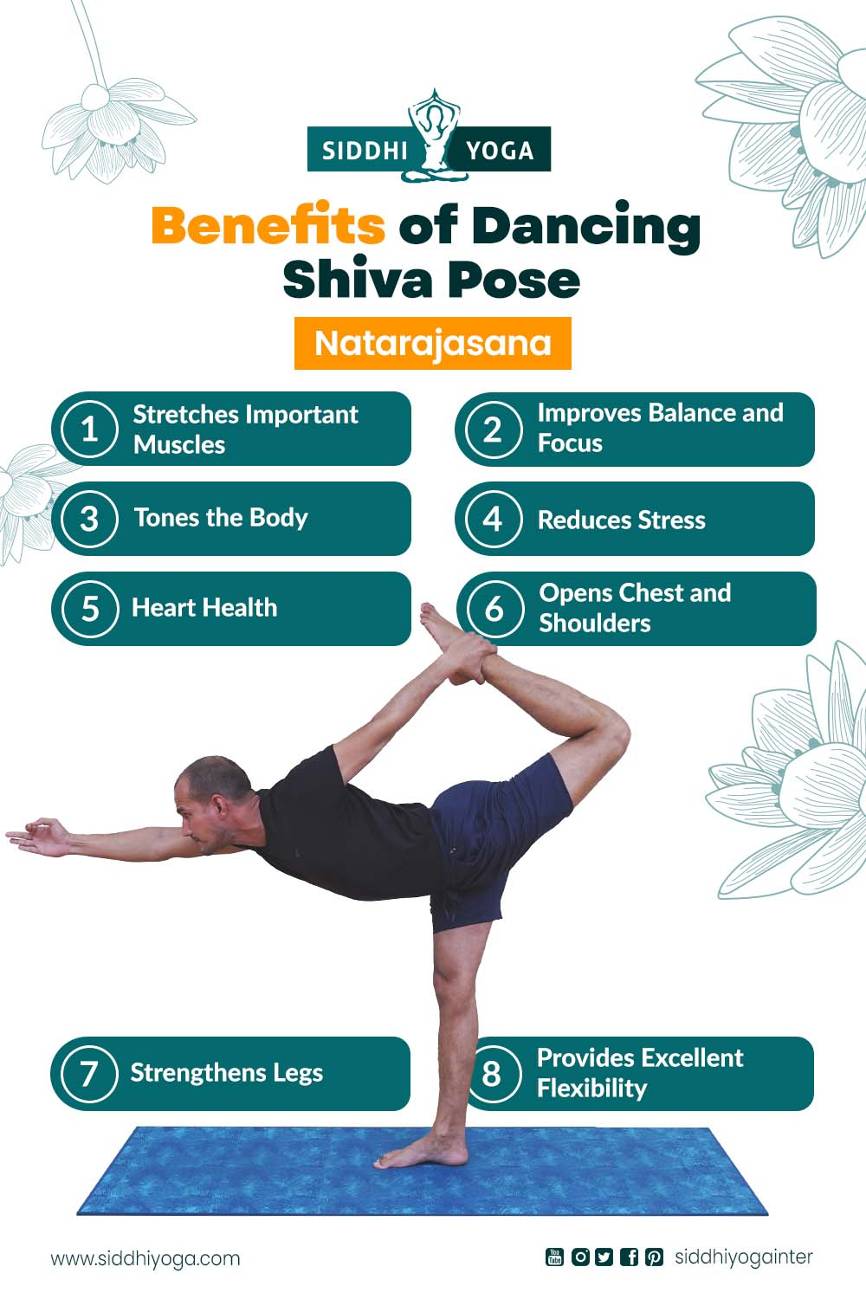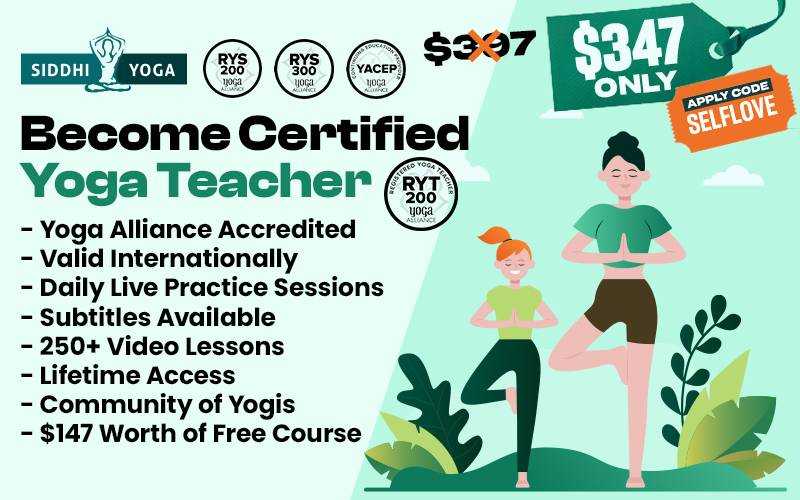
Raja = King or Lord
Asana = Pose; Posture
Natarajasana at a Glance
Natarajasana, also known as “Lord of the Dance Pose” or “Dancer Pose,” is a yoga asana that involves balancing and back bending. It needs to have a deep backbend which requires a lot of patience, focus, and persistence.
Benefits:
- Natarajasana requires strong balance and concentration, which helps maintain the overall sense of equilibrium of the body. This pose is a strength-building pose and increases the body’s overall strength.
- The pose stretches the muscles along the front of the body and helps increase the overall flexibility. It opens up the shoulders, chest, and thighs, increasing flexibility and helping to maintain balance. The posture requires concentration and mental focus.
- The pose can stimulate the abdominal organs, aiding digestion, promoting healthy organ function, and helping in low blood pressure.
Who can do it?
Individuals with good flexibility and balance, people with good physical health, have no major injuries, are familiar with yoga poses involving balance and back bending, and Intermediate to Advanced Practitioners. People who want to reduce weight and have low blood pressure should practice this pose.
Who should not do it?
People with pain in the lower back, hips, or knees, people suffering from hypertension (High Blood Pressure), heart conditions, during pregnancy, and spinal issues should avoid this pose. People with carpel tunnel syndrome should avoid this pose.
Introduction
Derived from the Sanskrit words “Nata,” meaning dancer, and “Raja,” signifying king or lord, Natarajasana represents the divine dance of Lord Shiva, who is often associated with creation, destruction, and the cyclical nature of existence. “Asana” refers to various poses in yoga for attaining physical and spiritual well-being.
So “Natarajasana” is the “Pose of the king of dancers”. The name directly goes to lord Shiva, who is behind the whole creation and dissolution of the universe. The posture exhibits the graceful and dynamic stance of lord Shiva’s dance. The posture invites the practitioner to align themselves with the universe’s rhythm, which is personified by Shiva.
Preparing for Natarajasana
Start with a good yoga warm-up, including some warm of other asanas like bow pose and cat-cow stretch. The dancer pose should be practiced empty stomach or after an hour of a very light meal. Then stand straight in Mountain pose and keep the entire body weight equally distributed on both feet. Find your balance and engage the core.
Watch the shoulder level. There should not be any stains. Shift your weight onto your left foot. Bend your left knee to lift your foot off the floor. Simultaneously, reach your right arm forward, parallel to the ground. Keep your hips square to the front. Keep your gaze steady and take deep breaths as you find your balance and comfort in the pose.
How to Do Natarajasana?
Follow the Step- By Step Procedure
- Begin with the mountain pose. The weight has to be equally distributed on both feet.
- Then, shift your weight onto the right foot and connect strongly with the ground.
- Then slowly, with proper breathing, bend your left knee to lift your left foot off the floor.
- Hold your left foot with your left hand. Extend your right arm forward at shoulder height. This will help you balance and counteract the weight of your lifted leg. Keep your hips level squared and engage the core.
- Keep your balance and lean slightly forward. You may keep a steady focal point to gaze in front of you.
- There should not be any hurry to release the pose, slowly release the left foot, get straight back to the mountain pose, and switch sides.
What are the Benefits of Natarajasana?

Strengthens Leg Muscles
It requires balancing on one leg, which engages and strengthens the muscles in the standing leg, including the quadriceps, hamstrings, and calf muscles.
Calms the Mind
The awareness of the pose with a gaze helps to calm the mind and increase concentration.
Boosts Confidence
As the pose opens the heart, it helps to boost self-confidence and inner strength.
Enhances Mindfulness
The nature of the pose is such that it encourages mindfulness.
Activates Manipura Chakra
It stimulates the Manipura (solar plexus).
Increases Blood Circulation
The pose helps maintain proper blood flow to various body parts, improving overall circulation.
In Low Blood Pressure
The asana is especially helpful in low blood pressure as it helps increase blood circulation.
Reduces stress
The posture is a heart-opening asana, thus helping in stress reduction and improving concentration. Diseases related to buttocks, thighs, groin, and abdomen. As the asana is a hip opener, it might be helpful in diseases related to these areas.
Physical Alignment Principals of Natarajasana
- Natarajasana is a pose done to grow spiritually. You can practice with a mudra for the extended arm or you can keep it without a mudra with gaze in front,
- When you lean forward, maintain your balance, as the pose requires strength, balance, and flexibility. Keep your foot firm on the ground. You can take support of a wall also. Keep your chest lifted, naval in, and relax in the pose.
- The hold of your hand and leg should be firm and comfortable. It should be according to your flexibility.
Health Conditions that Might Benefit from Natarajasana
Strengthens Leg Muscles
Natarajasana requires balancing on one leg, which engages and strengthens the muscles in the standing leg, including the quadriceps, hamstrings, and calf muscles.
Enhances Flexibility
The pose involves stretching the lifted leg’s quadriceps and hip flexors, increasing flexibility.
Opens Hips
It helps in improving the flexibility and mobility of the hips.
Improves Balance
Natarajasana is a challenging pose, but once mastered helps to improve balance.
Stretches Shoulders and Chest
The extended arm in the pose stretches the shoulders and chest, promoting improved posture and shoulder flexibility.
Mind-Body Connection
Balancing and focusing on the pose’s alignment enhances your mind-body connection and concentration.
Modification of Natarajasana with Props
Natarajasana with a Chair
Place a chair with its back towards you. Use a chair to support the hand and slowly lift the alternate foot to hold the toe with the hand.
Yoga Strap
Bring the strap close to the floor and make a loop with your hand, and the breathing slowly lifts your foot off the ground keeping the strap held. You can also keep a chair here for your support so you don’t lose your balance. Keep bringing the strap closer to your head till you are comfortable when you reach the final pose, and remain there for a few minutes. Repeat the other side.
Against a Wall
Maintain one-hand distance from the wall. Start lifting the right leg and extend the left arm towards the wall to reach it and get the support. Beginners may use this to get a good balance and mastery over the pose. Gradually you can increase the distance between the wall and you.
Natarajasana and Variations
Natarajasana B
After you attain the Natarajasana holding the right foot with both hands, pull it and rest the foot on the head; the gaze is upwards. It is a deeper stretch. Find balance.
Natarajasana 2
After holding the ankle with the hand, bend forward with the hips and keep the spine erect. Reach the floor with the fingertips of the right hand.
Nantum Natarajasana
When you hold the right big toe with the right hand behind the body, bring the right elbow forward and keep the upper body parallel to the floor.
Dancer Posture Variation
The pose is a next-level pose, which requires raising the right foot into your right elbow and using the left hand for support.
Safety and Precautions
Recent or Chronic Injuries
A person having chronic pain anywhere in the body should avoid this pose, as it may not be safe.
Hip or Knee Issues
The knees must be bent and raised to avoid extra stress on the knees. It should not be practiced with knee issues.
Back Problems
The pose demands back bending, so not recommended for people having severe back pain.
Shoulder Injuries
As one needs to engage the shoulders and neck, the pose is not recommended for people suffering from shoulder injuries.
High Blood Pressure
People having high blood pressure should avoid this pose as the pose demands strength, stamina and flexibility.
Pregnancy
The pose needs to engage the core. So, during pregnancy, it should be avoided to avoid any kind of strain on the abdomen.
Vertigo or Dizziness
The pose requires balance. Anyone suffering from dizziness or vertigo should completely avoid the pose.
Carpal Tunnel Syndrome
People with this syndrome should avoid this pose as the wrists are twisted to hold the toes to help get the leg high.
Common Mistakes
- Shoulders should be straight with no hunching. There should not be too much arching.
- The leg should not be very high. It should be according to comfort level, keeping the hips square with the ground. To get the balance, the core should be well-engaged.
- Don’t hold the foot too tight with any kind of discomfort to maintain the integrity of the pose. Keep your standing leg active.
- While switching the sides, again stand straight. There should not be any kind of hurry.
- Even if the pose is done properly, if you are not using a focal point, it may not support you completely as it may lead to problems with balancing.
- Maintain steady and deep breaths throughout the asana.
- It is always advisable to practice within your limits and with the help of a certified yoga teacher.
- Chakra is associated with personal power, self-esteem, and confidence.
Natarajasana and Breath
- Inhale raising the left foot behind, bending the knee, and exhale, holding it from behind with the left hand. Inhale raising the left foot and, according to comfort level, keeping the right arm stretched in front in Gyan mudra.
- Exhale keeping the thumb curled with the index finger and maintaining the toes between the thumb and the index. Maintain the balance and repeat it on the other side. This yoga posture helps in maintaining a good respiratory system and is also a good posture to set a backbend series.
Follow-Up Poses
- Vrikshasana (Tree Pose).
- Anjanayasana (Low Lunge).
- Ardha Chandrasana (Half Moon Pose).
- Utthita Hasta Padangusthasana (Extended Hand-to-Big-Toe Pose).
- Warrior III (Virabhadrasana III).
- Dancer’s posture (Natarajasana) variation.
- One-Legged King Pigeon Pose (Eka Pada Rajakapotasana).
- King Dancer Pose (aka Natarajasana).
Take Away
Natarajasana helps aid a good digestive system, makes the spine supple, and helps in even weight loss by increasing the metabolism. It is a good practice to boost your self-confidence and maintain a balance inside and outside. It helps keep the shoulders, arms, legs and back strong. When practiced regularly, helps in the overall well-being of the person. This pose is practiced to overcome fears and experience the ultimate liberation.
Unlock the door to a fulfilling career in yoga instruction with our accredited yoga teacher training courses. Choose from our foundational 200-Hrs Yoga Teacher Training Course, advanced 300-Hrs Yoga Teacher Training Course, or the all-encompassing 500-Hrs Yoga Teacher Training Course – all certified by Yoga Alliance, USA. Immerse yourself in the world of yoga philosophy, anatomy, teaching methodologies, and more. Embrace this opportunity to become a certified yoga instructor and inspire others on their path to wellness. Enroll now and embark on a transformative journey!

Responses